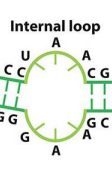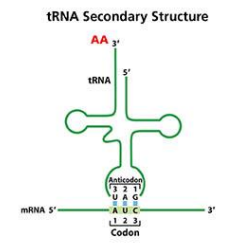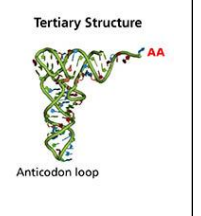Lecture 14 - nucleotides mainly rna new one
1/46
There's no tags or description
Looks like no tags are added yet.
Name | Mastery | Learn | Test | Matching | Spaced |
|---|
No study sessions yet.
47 Terms
Why RNA is Less Stable than dna
Ribose has a 2' hydroxyl group (-OH), while DNA lacks this (just H at 2').
This OH can act as a nucleophile (especially in basic conditions), attacking the phosphate backbone → forms a 2',3'-cyclic phosphate → causes cleavage of the RNA chain. (This results in cleavage of the phosphodiester bond and breaks the RNA strand.)
DNA is more stable because it doesn’t have this reactive -OH group at 2'.
under what conditions does rna get hydrolyzed?
RNA gets hydrolyzed in alkaline conditions, while DNA doesn’t — that’s why RNA degrades more easily in the cell.
how does RNA make secondary structures?
RNA is Single-Stranded, but:
It can fold back on itself by forming base pairs (like A=U, G≡C).
This creates secondary structures such as hairpins or stem-loops (looks like a double helix in small regions).
why doesnt chargaffs rule apply to RNA?
In DNA: A = T and G = C (Chargaff’s rule).
In RNA: Not true, since it's single-stranded — you don’t expect equal amounts of A and U or G and C.
how is RNA sequences related to the DNA sequence?
RNA Sequence is Complementary to the DNA Template Strand:
RNA is made from the DNA template strand during transcription.
Therefore, its sequence matches the anti-template (coding) strand, but with U instead of T.
what are types of RNA secondary structure forms? (4)
Hairpin
Internal loop
Buldge
Single strands
what is a hairpin structure?
A tight loop at the end of a paired region — common in RNA.

what is a internal loop?
Unpaired bases on both strands between two paired regions.

what is a bulge
An unpaired nucleotide on one side of a base-paired region.

what is Single strands structure?
Regions that remain unpaired.

what are some examples of tertiary structure seen in RNA?
tRNA - Classic example of RNA tertiary structure. It has a cloverleaf secondary structure, but folds into an L-shaped 3D structure.
Hammerhead ribozyme - An RNA with enzymatic activity — it catalyzes chemical reactions (yes, RNA can act like an enzyme!).
what a type of pairing you only see in rna
unusual base pairing (non-Watson-Crick base pairs)
what is unusual base pairing?
You’ll see non-Watson-Crick base pairs, like G=U wobble pairs. These are weaker than standard G≡C or A=U, but still contribute to the structure.
These interactions help stabilize tertiary folding and often occur in functional RNAs.
what are the major type of RNA cells
Messenger rna
Transfer rna
ribosomal RNa
Mico RNA
how are these four cells made?
Through transcription
Transcription = Transcription: DNA is used as a template to make a complementary RNA strand (mRNA).
function of messenger rna?
Transcription:
The DNA template strand is transcribed into a complementary mRNA sequence.mRNA Transport & Role:
The mRNA carries genetic instructions (a copy of the gene) from the nucleus to the ribosomes in the cytoplasm.Translation:
Ribosomes read the mRNA codons (three-base sequences), and using the genetic code, assemble amino acids in the correct order to form a polypeptide chain.Protein Folding:
After translation, the polypeptide folds into its functional 3D structure to become an active protein.
what are structural features of the messenger rna?
5′ terminus is Capped
3′ Poly-A Tail:
function of the cap?
5′ Cap:
A 7-methylguanosine triphosphate is added to the 5' end of eukaryotic mRNA. There is alot of RNa in the cell so cap helps ribosome recognize the mRNA
This cap:
Helps ribosomes recognize mRNA
Protects mRNA from degradation by ribonucleases (enzymes that break RNA)
function of 3′ Poly-A Tail?
A tail of 20–250 adenines is added to the 3′ end.
This tail:
Stabilizes mRNA
Helps with ribosome recognition
Slows degradation
function of tRNA?
Acts as an adaptor molecule during translation.
Delivers amino acids to the ribosome based on mRNA codons.
Structural features of tRNA (3)
Size: 73–93 nucleotides long (~25,000 MW)
Number: At least 20 types, one (or more) for each amino acid.
The tRNA secondary structure looks like a cloverleaf. Each has an ACC sequence at the 3' end (where the amino acid attaches)
what is the anticodon region?
An anticodon region at the bottom loop recognizes the three-base RNA sequence that specifies a given amino acid, thus correlating the RNA sequence to an amino acid sequence.
The anticodon region of tRNA is responsible for ensuring that the correct amino acid is added to the growing polypeptide chain during translation.
what are the structural components of tRNA secondary structure?
Secondary structure: Classic cloverleaf with 4 arms.
One arm has the anticodon loop (binds mRNA codon).
The 3′ end always has ACC, where the amino acid attaches.

tertiary structure of tRNA
Tertiary structure: Folds into an L-shaped 3D conformation, aligning the anticodon and the amino acid at opposite ends.

functions of trna
tRNA acts as a translator: It matches mRNA codons to their correct amino acids during translation at the ribosome.
The anticodon recognizes the codon, and the attached amino acid is added to the growing polypeptide chain.
what is a ribosome?
The ribosome is a large cytoplasmic structure made up of proteins and RNA.
function of ribosome?
This complex acts as a massive enzyme complex that synthesizes proteins based on information encoded in mRNA, and interpreted using tRNA molecules
Ribosomes are extremely complex, containing four different rRNA molecules and about 80 different proteins
what are two subunits of ribosomes?
60s
40s
what does the 60s subunit contain?
– 5S rRNA, 5.8S rRNA, 28S rRNA, and – 50 different polypeptides (“ribosomal proteins”)
what does the 40s subunit contain?
– 18S rRNA + 30 polypeptides
what does the S refer to?
The S refers to the sedimentation coefficient refers to how fast a particle (like a ribosomal subunit) sediments when spun in an ultracentrifuge.
Sediment" (in this context) means: To settle to the bottom of a liquid when spun very fast in a centrifuge.
what are microRNA?
Very small RNA molecules (~22 nucleotides).
Initially transcribed as longer precursors (~100 nt) and processed by ribonucleases to become mature miRNAs.
functions of microRNA
Regulates gene expression (not directly involved in translation like mRNA, tRNA, or rRNA).
miRNA is complementary to specific mRNA sequences → forms a complex between microRNA and mRNA . so prevents mRNa from being used by ribosomes to make proteins
what could happen to miRNa and mRNA complex?
in some cases the miRNA:mRNA complex is destroyed by enzymes, and in other cases the complex survives, but the mRNA is “silenced”
Biological role: of miRNA?
miRNAs help to prevent the overproduction of particular proteins during important biological processes, e.g. during embryonic development
what are mutations?
Mutations are changes in DNA base sequence (replacements, deletions or insertions of bases) that lead to changes in the genetic information carried by the cell. This process is important in aging and cancer.
types of dna damage that can cause mutation? (6)
Deamination of C --> U
Depurination
UV light
X-rays and other ionizing radiation
Oxidative damage
Chemicals
what is deamination?
A spontaneous mutation where a cytosine (C) loses its amine group and becomes uracil (U).
Occurs at a rate of 1 in 10⁷ bases per day in DNA.
why is deamination a problem?
Uracil is not normally in DNA, only in RNA.
If DNA used U instead of T, repair enzymes couldn’t tell normal U from a mutated (deaminated) C.
That's why DNA uses thymine (T) — so if a U shows up, it's clearly a mistake and can be repaired.
how does dna repair this problem?
DNA repair enzymes scan for U in DNA, then remove it and restore the correct C.
Other types of deamination (like adenine → hypoxanthine) happen more rarely (1 in 10⁹ bases/day).
what is depurination?
1 /105 purines per 24 h. This is the outright removal of a purine base from the phosphodiester backbone, and again requires constant repairs
Depurination is much slower in RNA.
how does UV light dmg dna?
Cause: UV light hits DNA where two thymines are stacked. It causes covalent bonds to form between adjacent thymine bases.
Result: Formation of two types of photoproducts:
Cyclobutane pyrimidine dimer (most common)
6-4 photoproduct
Effect: These abnormal bonds distort the DNA helix, causing kinks, and block replication and transcription. can dmg sugar-phosphate backbone
Repair: Normally fixed by nucleotide excision repair (NER) pathways.
why does Oxidative Damage cause dmg?
Source: Reactive oxygen species (ROS), like H₂O₂, hydroxyl radicals (OH•), and superoxide (O₂⁻).
Damage: Can cause base modifications, strand breaks, or even crosslinking.
These free radicals are byproducts of normal metabolism but increase with stress or radiation.
what are the types of chemical s that cause dmg and how do they do it? (3)
Nitrous acid: Deaminates bases (e.g., converts C → U).
Alkylating agents: Add alkyl groups to DNA, disrupting base pairing.
Base analogs: Base analogs are chemical compounds that are structurally similar to the normal nitrogenous bases (A, T/U, G, C) in DNA or RNA — but they have slight differences that allow them to get incorporated into DNA during replication and cause mutations.
what are mutagenic agents?
Mutagenic agents: Substances that cause mutations in DNA.
Carcinogens: A subset of mutagens that specifically cause cancer.
Cancer arises when mutations affect growth regulation genes, allowing uncontrolled (tumors) like:
Proto-oncogenes
Tumor suppressor genes
how do tumor cells arise?
Tumors arise from multiple mutations — not just one.
Specifically:
These mutations occur in different genes that are responsible for controlling how and when cells grow, divide, or die.
1. tumor suppressor
proto-oncogene
dna repair genes
regular function of those 3 genes?
Gene Type | Normal Role | Effect if Mutated |
|---|---|---|
Tumor suppressor | Acts like a brake on cell division | Brakes fail → uncontrolled division |
Proto-oncogene | Encourages normal growth in response to signals | Becomes an oncogene → always ON |
DNA repair genes | Fix DNA damage and maintain stability | Damage builds up → more mutations |
Proto-oncogenes (e.g. RAS, MYC): Normally help regulate cell growth, but when mutated, become oncogenes that drive excessive growth.